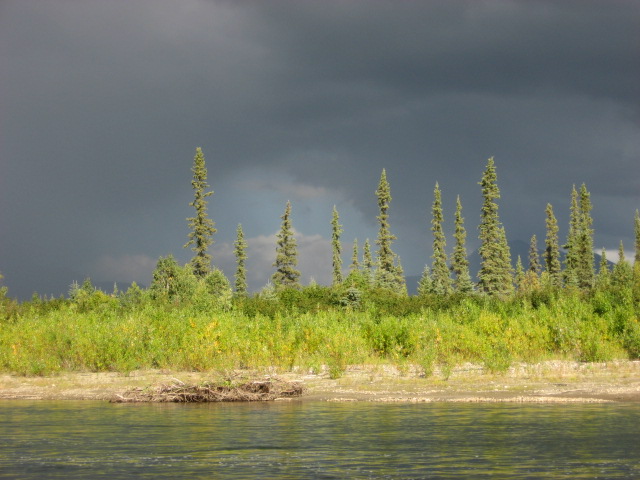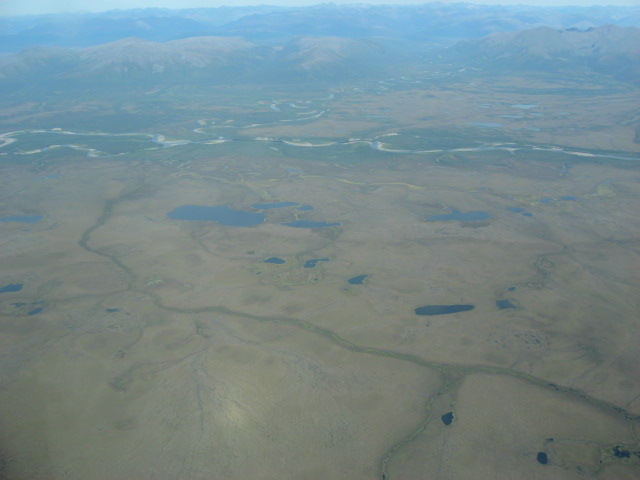The vegetative communities adjacent to the Kobuk River are comprised of alpine tundra; successional willow/cottonwood forest and climax spruce boreal forest on well-drained soils; and lowland tundra on poorly-drained soils. Soil drainage is determined by slope, soil type, bedrock type and the presence of permafrost.

Within the immediate proximity of the Kobuk, clear vegetative patterns emerge that are the result of river movement. The cut bank of an outer bend typically will be dominated by old-growth spruce. Climax spruce forests are in the range of 150-200 years old. Along the inner bank, where gravel and soil are being accreted, a successional forest can be seen. Adjacent to the river are gravel beds with interspersed grasses, annual forbs, bryophytes and yearling willow shoots. A band of willow, alder and birch follow, in lines that parallel the course of the river. Behind this is old growth spruce forest, generally black spruce, punctuated by an occasional white spruce in moister areas. As the meander progresses away from the inside bank, the succession follows it. When the meander reverses direction it cuts away at the climax (late successional) forest that developed behind it.
The time span of this cycle is determined by the width of the meander corridor and the speed of river migration. Although the speed of migration may increase with warmer temperature (due to increased rainfall, melting permafrost and increased hyporheic flow), it seems unlikely to affect the development of climax forest, since the timescale of river movement and forest development differ by an order of magnitude (100’s of years for forest growth, 1000’s of years for a migration cycle).
These patterns of vegetation appeared to dominate most of the Kobuk River Valley below the canyons, and they are a function of the discontinuity of permafrost along the river banks, allowing for relatively well-drained soils where permafrost is absent. Behind the curtain of spruce forest, on a larger spatial scale, another pattern emerges which is dominated by a permafrost layer that impedes water drainage. This region is dominated by a lowland tundra of lichens, mosses, blueberries and cranberries and other low shrubs. Lakes and ponds create a mosaic of habitat both aquatic and semi-terrestrial. The most well-drained soils occur in tussocks formed by cottongrass which are only a footstep across. The channels between tussocks are wet. This tundra forms the vast majority of the river valley, but it is often invisible from the river because of the thick curtain of taiga spruce forest.

At the edges of the river valley, along the slopes of mountains, well-drained soils above bedrock or glacial deposits support spruce taiga. This creates the appearance of an inverted tree-line, with alpine-like tundra below and dense forest above up to the tops of the mountains—except for the larger mountains, where a true alpine tundra develops again, leaving a band of forest along the mountains and a narrower band along the migrating river.
If climate change produces thermokarst erosion (i.e, melting of permafrost), which is likely, an expected result would be the loss of the tundra lakes and ponds and a drop in the water table. Following this initial disturbance, a number of intermediate changes would be expected: loss of nitrogen and phosphorous from the system, increased erosion and deposition to the river, and a change in flora. If stabilization occurs, the establishment of a succession similar to that seen on inside river meanders would be expected. First, pioneer grasses and annuals, followed by willow, alder, birch and then black spruce. Globally, an expansion of taiga to the north may be expected, much as has been described for plant communities in more temperate latitudes, which appear to be advancing north and upslope. The transformation of flora and river dynamics may have large and unforeseen impacts on ecosystem structure, nutrient dynamics, species assemblages, and human culture in the region.
References
Hinsman, LD et al. 2005. Evidence and implications of recent climate change in northern Alaska and other arctic regions. Climatic Change 72: 251–298.
Parmesan, C. 2006. Ecological and evolutionary responses to recent climate change. Annu. Rev. Ecol. Evol. Syst. 37: 637–69.
Walther, G-R, et al. 2002. Ecological responses to recent climate change. Nature 416: 389-395.
